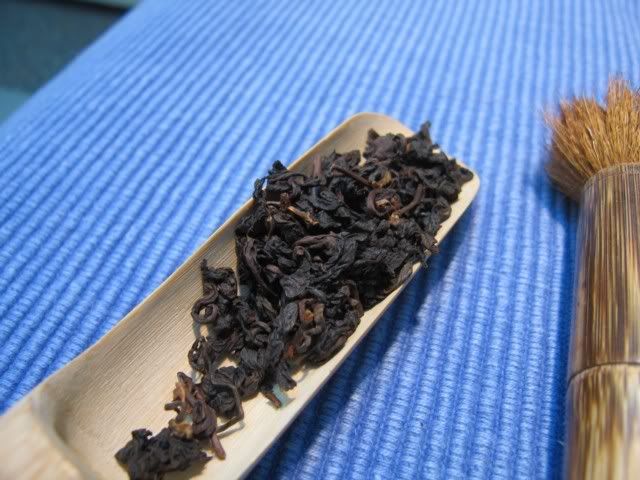I sat down yesterday to drink the competition tea that I got from the candy store right before I left. I only have a small bag of this stuff, so I suppose I shouldn’t drink it all too quickly, but it’s tempting.
This tea is supposedly around 25 years old, and entered some competition back then. I am not sure if it won anything, but it doesn’t really matter. What matters is that this tea is very well stored, and display no sourness or really anything that is undesirable.

The colour of the tea is a pleasant orange. I think aged oolongs that have this sort of colour are generally of the unroasted (or rather, un-reroated) kind. The ones that develop a darker colour often have been reroasted at some point. That’s not to say they’re bad, just different. For teas that haven’t been re-roasted, I find that they develop a fruity perfume, and tend to die a little faster than the reroasted teas.

This competition tea is the same — it starts out with an intense peachy aroma, gradually giving way to a more “tea” like flavour, but never really gaining any sort of bitterness or roughness. It’s smooth and sweet. What I like about it is the good qi that comes from it — an obvious sense of energy that only really show up with better teas. Different teas have different ways of displaying their qi. There are those that knock you over the head, and those that only slowly makes you feel warm and fuzzy. Not surprisingly, I like the latter kind.
The tea gets more subdued after 5-6 infusions but lasts quite a while. I’ve been using my new black pot to brew, and I find that even teas that had a little sourness in them no longer display that quality. The aroma also has gained a little more focus, for some reason. I’ve also used relatively less leaves than I would with a gaiwan.

I need to keep experimenting with my new pots…. I think today I’ll try the zhuni one to compare how they do for aged oolongs.

3 responses so far ↓
The one that got away | A Tea Addict's Journal // June 15, 2011 at 11:54 pm |
[…] them was a small, perhaps 2-3kg bag of rolled oolong with a label that said it was from the 80s, a Dongding competition tea. I only got to try the tea after I left Taiwan, because I had no time to do it before flying […]
Marlon // July 29, 2011 at 2:09 am |
MarshalN,
I was discussing the need for re-roasting aged oolongs with a friend just yesterday, and he was saying that they need to be re-roasted every 12-18 months to dry them out and avoid gathering a sour/off taste. Do you think that storage plays a large factor that my friend may not have considered, and that perhaps because of the type of storage, your tea has not developed a sourness even without re-roasting?
Also, how do you store your aging/aged oolongs? Just beginning to get into them and want to make sure I get it right.
Thanks for the help,
Marlon
MarshalN // July 29, 2011 at 2:14 am |
What your friend is saying is a common perception — that oolongs need to be reroasted. I think that’s true for the most part, and that they can easily go sour. I think though that some well processed teas don’t need that treatment, and also, that roasting should probably be done as sourness appear, rather than preemptively because I think a lot of the often reroasted teas are rather boring and bland.
Store them well, doesn’t have to be vacuum sealed but should be very air tight.